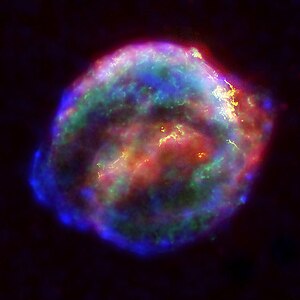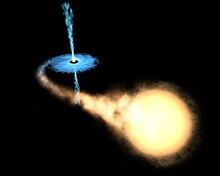General Astronomy/Life of the Black Hole

In this subchapter, we examine the life of the black hole, from its birth in the fires of a dead star, to its gradual dissipation in the backwaters of space.
Birth - Part I
[edit | edit source]It would only make sense to begin chronologically, at the moment when the black hole is formed, shortly following the death of a sufficiently massive star. Before this, however, we must first understand what causes the death of this star. In short, such a star will collapse when its temperature is no longer high enough to stop it from collapsing under its own gravity. There are two possible reasons for this failing of equlibrium. The more common cause occurs when a star has burned up all of its nuclear and elemental "fuel", and can therefore no longer maintain the necessary temperature, resulting in what is termed "gravitational collapse". The second possible cause of this imbalance between temperature, pressure, and volume involves the star taking on a significant amount of added mass in some way, without causing the necessary increase in core temperature to support the additional mass.
Either way, the star now no longer has the needed temperature to stop a collapse. The star's core is compressed so tightly, that it forms what is known as degenerate matter, which is, essentially, matter that is so highly compressed that the forces of repulsion that creates the supporting pressure originate from quantum mechanical effects not from the usual forces of repulsion of like charges of normal matter. Its comprising particles are extremely dense. The collapse usually triggers subsequent events, such as supernovae, or gaseous fragmentation into planetary nebulae (shells of gas and plasma), that shed the outer layers of the star. The remnant that is left after the collapse and subsequent events forms one of a number of "compact stars". These include white dwarfs, neutron stars, and, of course, black holes. For the latter to be a result, the remnant has to be sufficiently massive; just how massive is defined by the "Tolman-Oppenheimer-Volkoff limit", calculated by Julius Robert Oppenheimer and George Michael Volkoff, in 1939. Beyond this limit the gravitational attraction is greater than the opposing pressure, and, when the remnant's outer radius drops below its Schwarzschild radius, the black hole is fully formed.
The black hole emerges thus from the ashes of a broken star, and the birth is complete.
On a final note, before we continue, there is a second way that black holes can be formed, though it is much rarer for this to happen: the collision of two neutron stars—another form of "compact star"—can sometimes result in the formation of black holes. However, such collisions are not common, and this second possible cause of black hole birth is not always mentioned in short summaries of black hole formation.

Life - Part II
[edit | edit source]The life of black holes is impossible to calculate, and how long they remain has only been predicted, not proven. Therefore, generalization is inevitable.
As black holes drift through space, they exist as vacuum machines of sorts, sucking in all the matter they come across, and steadily growing. As they devour, stellar black holes—forged from the ashes of star corpses—grow, becoming larger through a process called accretion. This refers to the growth of massive bodies due to the attraction of matter by gravity. Those black holes that devour many stars, planets, interstellar matter, or even other black holes often become substantially larger than average stellar black holes. How long a black hole feeds at a particular location depends on what it is consuming. Large stars often take eons for black holes to consume, while smaller objects—such as asteroids, small planets, or moons—take a comparably small amount of time.

Death - Part III
[edit | edit source]This next section inevitably launches into the realms of theory. Because all but the micro black holes are predicted to live for longer than the current age of the universe, the death of a black hole possibly has not even occurred yet.
One theory, Hawking Radiation, denotes that every black hole, after a very long time, will eventually evaporate into nothing. Thus far, it is one of the few proposed theories regarding black hole evaporation, and remains a hotly debated topic. It is this theory that we will discuss here.
Even in the total vacuum of space, there is energy. Quantum mechanics says that even a true vacuum is not empty, in the sense that it is in fact a sea of zero-point energy. This body of energy fluctuates much like waves in a sea. These fluctuations continue to produce pairs of particles—one normal matter particle, and one antiparticle—that meet and are re-converted back into pure energy, restoring the balance in the sea.
Now, Hawking Radiation states that, if such a pair of particles were formed outside the event horizon of a black hole, and one of the two moves over the event horizon, while the other escapes, then the black hole will lose a small portion of its mass, because, in order to preserve "total energy" (the sum of an object's rest, potential, and kinetic energy), the particle which falls in must necessarily have negative energy.
However, only the smallest black holes could possibly evaporate in this way, because a black hole any more massive than Earth's moon would have a larger constant intake of cosmic microwave background radiation—the electromagnetic radiation that fills the whole universe—than it would emit through Hawking radiation. Indeed, there are currently no known, nor predicted, black holes even close to being the same mass as our moon, and therefore, as of now, Hawking Radiation is not, technically, a viable cause of evaporation in the present universe.
However, the cosmic microwave background radiation that fills space is slowly becoming weaker. Eventually, it will become so weak, that even the largest black holes will emit more by Hawking Radiation that they take in. In this way, after approximately a googol (10100) years, even the very largest black holes would evaporate.
And so, the life of the black hole concludes, when it returns to nothingness, in the depths of space.